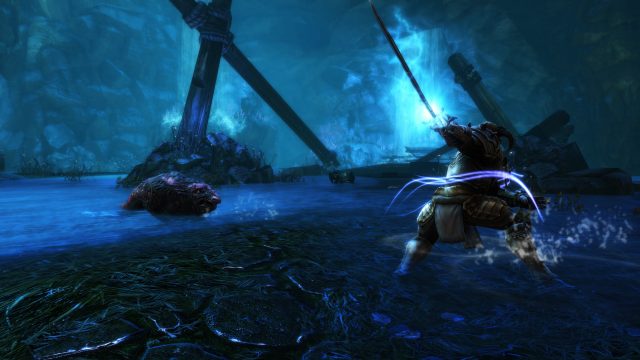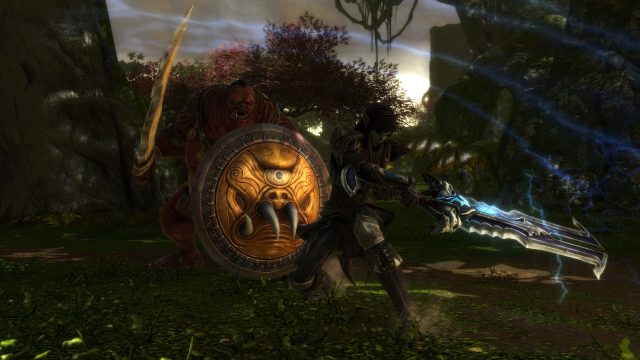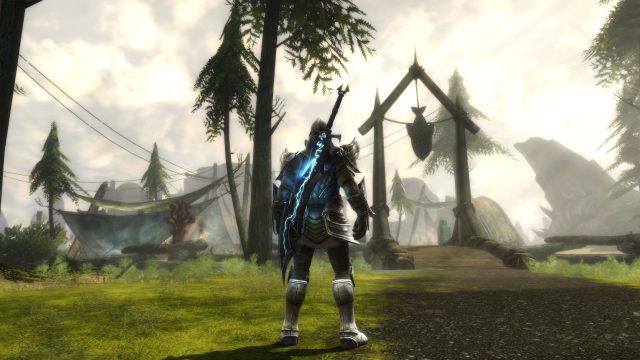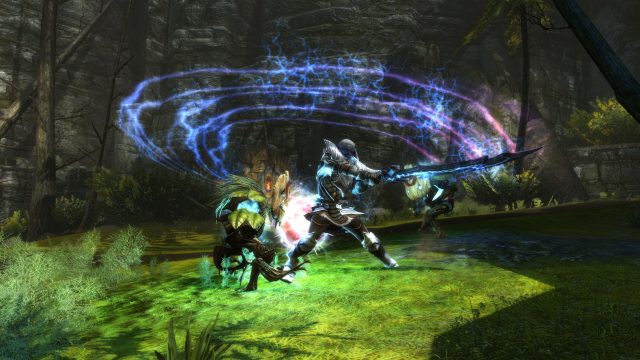On February 7th, 2012, Electronic Arts allowed consumers to enter a brand new world called Amalur. This exciting new IP, which blended role-playing with fantastical elements, action-oriented combat and the quest design of an MMORPG, piqued my interest and stood out because it came from a surprising source. Of course, I’m talking about the much maligned 38 Studios and its head honcho: former MLB all-star pitcher, Curt Schilling. Not just him, either. His assembled team also included none other than Spawn creator Todd McFarlane and fantasy author R.A. Salvatore.
Needless to say, there was a lot of pedigree behind this one.
I’ll always remember this game, because it was one of the most seminal moments in my career as a video game journalist or video game reviewer. Unlike any other game I’ve ever received, Kingdoms of Amalur: Reckoning arrived in a cheap plastic jewel case, and included only the disc. You’d think it had arrived months early, but if I recall correctly it was only a week in advance of launch. That meant my entire week was pretty much devoted to this game. Good thing I ended up loving it, and couldn’t get enough of it.
In the week prior to release, I spent thirty-eight hours playing this game. I took my time, completed most of the quests, and uncovered a lot of secrets. Although I didn’t get a lot of time with it, playing it never felt like work because it was simply so fun and engrossing. The combat was fun and felt fresh, the world was incredibly interesting and the character development (in terms of builds and options) really sucked me in. So, too, did the story, although it wasn’t the greatest thing I’d ever watched, read or listened to.

I ended up liking this game so much at the time that it cemented itself as one of my all-time favourites, even though it didn’t get the world’s best reviews or do as well as I’d hoped it would commercially, since I wanted a sequel badly. Although I was sent the PlayStation 3 version and effectively owned it, I ended up buying another version of the game down the road when it was on sale, and almost fully completed the list of quests again. At that time, I also bought the two DLC packs and thoroughly completed them as well.
Now, that game is back, and it goes by the name of Kingdoms of Amalur: Re-Reckoning. Cheesy subtitle aside, it’s a way to differentiate the two versions. There’s the original, which hit Xbox 360, PS3 and PC back in 2012, and now there’s this remastered version for PS4, Xbox One and PC.
Kingdoms of Amalur: Reckoning is an action-RPG, although it’s easy to mistake it for a first-person MMO due to its quest design and somewhat grindy gameplay. The lengthy campaign begins with a cutscene, which talks of a somewhat unexpected war between races in the world of Amalur. Things aren’t going well, and it’s looking as if the big bad is going to win. That is, until some elf-like creatures come up with a way to bring the dead back to life, and make the wise decision to return our player created hero to the world of the living.
The larger story centres upon a player crafted hero (or heroine) who carries incredible gifts, and has the ability to walk between fates. This allows for lots of character customization, because the way the game’s leveling system works is based on the fates and skills you choose. For instance, one can opt to be a might-based hero, which unlocks fate cards like the Brawler. These cards give you skill increases in certain, might-based areas.

On the flip side, those who aren’t like me and prefer to play these games from a more stealthy or magical vantage point can choose to do just that. Amalur’s classes are not set in stone, and they allow you to experiment with options. Furthermore, might is certainly not the only one available to those who pick up a controller and begin this fantastical quest. One can also opt to strike from afar and use stealth to their advantage, via the finesse class. Meanwhile, those who prefer magic can opt to use sorcery to their advantage as a mage. Either way, picking one doesn’t mean you need to stick with it. Every time you level up, you can choose a different fate card.
What’s nice about this game is that it also allows you to carry a crapload of different types of weaponry, and also lets you equip two at a time. One is mapped to one button (square on the PS4 controller), while the other is mapped to a different button (such as triangle). You can equip whichever primary and secondary weapon you’d like to, and can choose from numerous types, including long swords, great swords, hammers, staves, sceptres, throwable chakrams, daggers, ‘Faeblades’ and longbows. Finding the set-up that suits you best is part of the fun, and it’s not as if you’re ever penalized for trying different combos. In fact, you’ll continue to find loot for each class throughout the game, and only sometimes will things be locked behind stats, meaning that you’ll have to upgrade a certain class’ skill tree before being able to use that weapon or piece of armor.
Since I’ve always been a warrior, or might-based player, I once again went with my trusty long sword and hammer combo, although I did try different things off and on. Sometimes sneaking up on enemies and killing (or heavily damaging them) with one well timed stealth attack felt better than going in swords-a-swinging, and the game also rewarded me for doing so. On top of that, I also sometimes needed a fire-shooting sceptre to burn away progress or secret blocking spiderwebs.

You’d think that I’d want to drastically change things up for my third time through a massive RPG, but I’m a creature of habit. I have tried to make different decisions, but always find myself wanting to be a good guy as well. By that, I mean when it comes to some of Kingdoms of Amalur: Re-Reckoning‘s moral choices. These aren’t as important or as detrimental as the ones in Fallout 3 or its peers, but it’s nice that they’re included, and they do make you think a bit. Hell, I once told a spider queen that I would side with her and let her web-filled minions take over a town I’d helped and been given a home in for my efforts. This made me feel bad, and led to me reloading a minute old save so that I could make a different decision, even though I’d done the good thing twice already.
Before we move on from the combat, it’s important to note that things are pretty quick and fluid. There’s little in the way of a delay when it comes to pressing a button to swing your sword or hammer, but some weapons are obviously faster than others due to weight and size. The goal in Kingdoms of Amalur is to use everything at your disposal well, and to roll away from danger whenever possible. Another good idea is to use your shield as much as possible, because it allows you to block hefty amounts of damage, but mostly because it provides a way to deflect attacks. Doing this stuns enemies and allows you to retaliate quickly, not to mention with increased success.
The world of Amalur is full of good people of varying races, including the much talked about and confrontational Fae, who make up a lot of the enemies. These can take the form of bothersome boggarts or trolls, or even collectives known as the Court of Winter and Court of Summer. The winter Fae chronicle the decay of things, while the Summer Fae represent rebirth and growth. Either way, they can be challenging foes, especially if you wander somewhere where the enemies are more powerful than you are. This potential disparity is designated by the colour of the enemy’s type, which is listed above its head where its health bar also resides.

As mentioned above, this game is a lot like a single player massively multiplayer online roleplaying game. That’s because its campaign is structured in a very open, quest heavy and somewhat grindy kind of way. You’re always finding new quests and things to do, and need to complete a lot of side quests and kill a lot of enemies to level up. It takes the basics of a World of Warcraft style experience and gets rid of the social and online facets, while also borrowing things from Fable, The Elder Scrolls and more action-oriented games like Devil May Cry. After all, while Kingdoms of Amalur is an RPG, it does have combos that you can use to your advantage. Some even send enemies flying, much like in Capcom’s popular franchise.
Along your way, you’ll meet representatives from different houses, who will ask you to assist them with tasks. One may request that you find someone who’s gone missing and retrieve the sensitive information he was carrying, which will then lead you into one of the game’s many short (and honestly kind of repetitive) dungeons. Doing what they ask will then grant you access to their collectives, and will open up new questlines to complete. The main story, however, has you dealing with life as a newly reanimated corpse, who shows no signs of having been dead. Although you began this story on a cart that was then emptied into a basement where a rotting pile of many corpses kept adding up, you made it out with only a smell to show for it.
Through progression, you’ll find and complete many quests both big, small and fetch, save a lot of people, loot a ton of chests and warded containers, and get to build your character as you please. If you want to dabble in blacksmithing, make your own potions from the many plants that grow throughout Amalur, or add crystals to your weaponry then you can do that. The same is true of your home, which can be used as much or as little as you please. Play as you wish as you battle enemies and attempt to uncover the mysteries of fate, before taking on the big bad who threatens Amalur.

There’s honestly so much to this game, and so much to do within it, that it could take you a decent amount longer than the forty or so hours it usually takes me. Yes, the downloadable content adds length to that estimate, but so too does the scope of this experience. Those who are perfectionists will find tons to sink their teeth into, and the average gamer will also find lots of fun and content within this package. It’s honestly one of the best roleplaying games ever made. At least that’s my opinion, which still stands after more than 8 years.
When it was announced that THQ Nordic had acquired the Kingdoms of Amalur: Reckoning IP from Electronic Arts, I was ecstatic. With this being one of my favourite games of all-time, I’d always hoped for a sequel or some sort of remaster, especially during a generation that may end up being known as being the console generation of remasters. Hearing that the IP was still alive, and that it was in new hands made me excited. After all, why would they acquire it if they weren’t going to do anything with it?
Then, when I heard the news about Re-Reckoning, it became one of my most wanted games in quite a while. It releasing almost alongside Tony Hawk’s Pro Skater 1 and 2 was fitting, given that I felt the same about that game too. Both have helped re-ignite my love for gaming, and have been a blast to revisit. Now, here’s hoping that this remaster will do well enough to make THQ Nordic invest in a sequel. We really need one, and so does the IP. It’s had an unfortunate history, since it originally under-performed, and then became the subject of a scandal and a court case due to 38 Studios’ poor business dealings and workplace culture.
Kingdoms of Amalur: Re-Reckoning presents a great and underrated game in its entirety, and breathes some new life into an 8 year old campaign. Although it isn’t a full remake or the world’s most impressive remaster, the fact that it exists makes me happy. Yes, it’s imperfect, with some visual hiccups and a bit of hitching in the main character’s movement while running (although it only happens occasionally), but that’s okay. It is what it is, and this was never a technically perfect game. I’m just happy that it’s back, and that people are talking about it again. Keiko has also done a solid job bringing it to modern consoles, which I’m thankful for. I never expected this to be the most beautiful or polished update out there.

During the first part of the game, I didn’t experience any bugs or issues. However, I did encounter a follower glitch during the last quest of the Dead Kel DLC, and have had one crash. These are things that were problematic the first time around, so it’s disappointing that they aren’t fixed here. That said, I understand that I come at this re-release with rose coloured glasses, but I stand by what I’ve said and how I feel, because there’s a reason this game is a cult classic of sorts. There’s lots to like, and people who overlooked it may have made a mistake; at least if they like RPGs and have any interest in this type of experience. It’s flawed, and has some technical problems, but the core experience is so fun and immersive that they’re easy to overlook.
The sound design continues to be good, loud and fantastical, and the music is as great as it’s always been. The voice acting is well above average, the writing is quite good (thanks to R.A. Salvatore) and the world feels alive. Its different regions (forest, arid desert, dark and destroyed, plus a jungle-like world presented in the DLC) are all immersive and detailed, and the sound design really adds to this. The result is a game that looks and sounds quite nice, albeit slightly dated, and is easy to get lost in. This thing is worth it for the art design alone, but the gameplay is lots of fun too.
At the end of the day, Kingdoms of Amalur: Re-Reckoning is something I strongly recommend. Although it isn’t perfect, and contains some of the issues that the original versions did, I never expected a flawless or award winning remaster. The fact that this game is now updated and released for Xbox One and PS4 simply makes me happy, and it’s been a joy to return to the world of Amalur. I’ll sit down and expect to play for an hour, then find that I’ve been sucked in and don’t want to stop playing. Then hours go by, and I’m telling myself, “Just one more quest.”
This review is based on a copy of the game that we were provided with.

